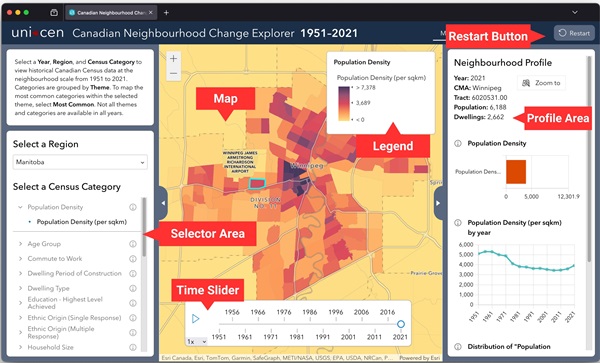Western University’s Network for Economic and Social Trends have launched an online mapping portal allowing users to map and explore historical census data dating as far back as 1951. The UNI-CEN Canadian Neighbourhood Change Explorer, 1951-2021 can be viewed here.
See the full news update from Western University’s Network for Economic and Social Trends below:
Western researchers launch new web mapping portal to explore how neighbourhoods change
The face of Canadian cities has been almost completely transformed over the past several generations. Immigration, the decline of industry, the rise of office work and the service economy, infill and redevelopment – all have changed downtown and suburban neighbourhoods alike.
While the Canadian census contains a wealth of information about neighbourhoods from the Second World War to the present, accessing these data and using them to visualize neighbourhood change has required specialized skills.
To fill this gap, researchers from Western University’s Network for Economic and Social Trends (NEST) have created an online map portal, the UNI-CEN Canadian Neighbourhood Change Explorer, 1951-2021, that enables Canadians to visually explore historical data from the 15 censuses taken over the seven decades spanning 1951 and 2021. People can access the portal at https://edumaps.esri.ca/census/.
Users can explore a wide variety of neighbourhood characteristics. They can map social variables, including concentrations of ethnic origin, Indigenous identity, language, religious groups, and immigration status. They can also look at how people live and move through the city: housing types, owning versus renting, commuting behaviour, and population density. And finally, they can look at work and the economy, including income, educational attainment, and what types of jobs neighbourhood residents have had. Most importantly, they can not only map single census years, but use graphs to visualize change over time in specific neighbourhoods.
The project is led by Professor Zack Taylor, who worked closely with Mitacs postdoctoral fellow Christopher Hewitt and developers in Esri Canada’s Education and Research group. Esri is a world leader in geographical analysis software. Aspects of the project were funded by Western’s Faculty of Social Science, Mitacs, the City of Toronto, and SSHRC.
“The portal is an engaging way for users to explore how Canadian neighbourhoods have changed over time”, said Professor Taylor. “We can see how neighbourhoods in our cities have become more ethno-racially diverse, how households have changed, and how income levels have polarized. We have high hopes that this exploratory tool will be used not only by researchers, but also by social service organizations, government departments, and students.”
The map includes all census tracts nationwide in each census year. Census tracts are neighbourhood-sized units defined by Statistics Canada. The project leverages two products developed at Western’s Network for Economic and Social Trends. The first is the Unified Infrastructure for Canadian Census Research (UNI-CEN), which contains census data and geographic boundaries covering the post-Second World War period. The second is the Canadian Longitudinal Tract Database, which harmonizes census data released for different neighbourhood boundaries across census years.
“This is a great example of projects led by NEST researchers that will benefit communities across the country and support Western University’s strategic priority of serving the public good. We could not have completed this project without the generous support of the Faculty of Social Science and the creativity and resources of our partners at Esri Canada’s Education and Research Department,” said Victoria Esses, Director of the Network for Economic and Social Trends. “University-industry partnerships like these can unlock new insights and open up community access to data.”
Esri Canada Director of Education and Research Jon Salter agrees. “Creating the Neighbourhood Explorer led us to apply Esri software tools in new ways and develop novel approaches that will be valuable for our community of users. Our collaboration with Western fits with our core missions of making innovative use of our products and making geographic information and spatial analysis more accessible,” he said. “We’re excited by the project and look forward to seeing how it is used.”
Source: Western researchers launch new web mapping portal to explore how neighbourhoods change
